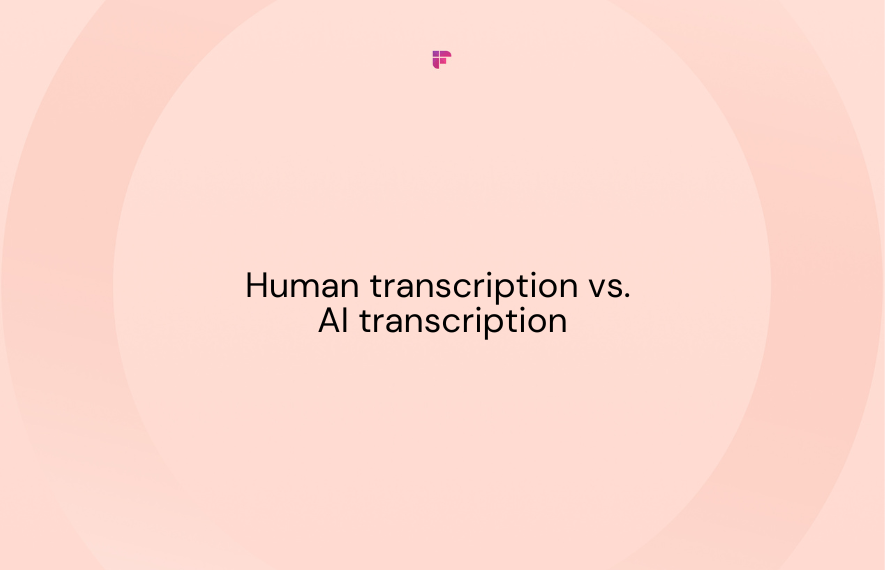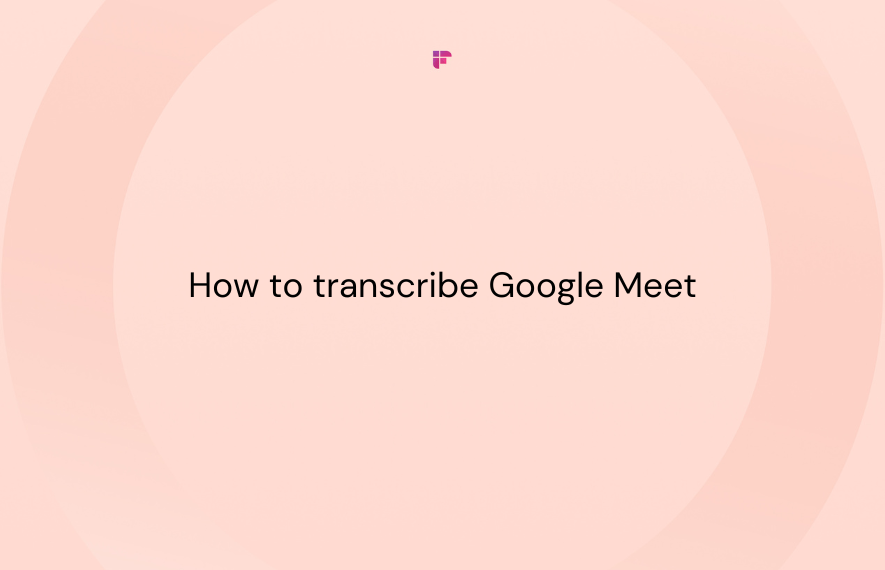Human transcription vs. AI transcription: two powerful forces competing for supremacy in converting speech to text. But which side should you choose?
In this blog, we dive deep into these transcription methods—advantages, disadvantages, key differences, and more, enabling you to make an informed decision.
Read on to find the perfect fit for your transcription needs.
Human transcription vs. AI transcription: how to decide?
Transcription means converting spoken language or audio recordings into written text. It eases the documentation of large files and makes the content easy to search, refer and analyze.
You can do it in two ways:
- Automated transcription
- Human transcription
What is automated transcription?
Automated transcription refers to using technology, particularly artificial intelligence (AI), machine learning algorithms, and speech recognition technology, to automatically convert audio/video recordings into written text without requiring manual efforts.

Many AI transcription tools are available today; most are easy to use.
For example, Fireflies is an AI transcription tool that can transcribe, summarize, and analyze your meetings and multimedia content with 90%+ accuracy within minutes.
To transcribe your recordings, upload the audio or video file into the tool, and it will automatically generate the transcription within minutes, depending on file size.
💡 Fireflies Tip
Do not just limit your transcription capabilities to audio/video recordings. Record, transcribe, and summarize all your online meetings instantly with Fireflies. Say goodbye to tireless note-taking and focus on what matters most—productive discussions.
When to use automated transcription?

Here are some situations where AI tools are the best choice for transcription:
- High-volume content
- Time-sensitive projects
- Projects with budget constraints
- Documentation, content indexing, and search
- Generate rough drafts
1. High-volume content
Automated transcription can handle heavy workloads efficiently. When you need to transcribe large files or lengthy content, use AI transcription to do it fast and accurately.
2. Time-sensitive projects
Regarding AI vs. human transcription, the former is well-known for faster turnaround time. AI tools can generate a quality transcription of lengthy audio or video in just a few minutes.
So, when you need transcription for projects with time constraints, use AI tools.

3. Projects with budget constraints

Human transcription typically costs $1.30 to $3.50 per minute.
In contrast, automated transcription tools like Fireflies offer free transcription credits and affordable paid plans that start at just $10/user/month, allowing unlimited transcription in just a few minutes.
This makes automated transcription a suitable option for projects with a limited budget.

4. Documentation, content indexing, and search
Do you have to sort through a massive collection of audio or video files to sort through and find specific information or keywords? Manually doing it is time-consuming and tedious.
This is where automated transcription helps. It simplifies the indexing and searchability of vast audio or video content.
It quickly converts spoken words into written text, enabling easy documentation, retrieval, and analysis of specific information or keywords.
Easily filter out important information with AI filters of Smart Search, annotate key parts by adding comments as Threads, snip out highlights of the content as Soundbites, and save these highlights into a single Playlist for easy reference.

5. Generate rough drafts

Automated transcription offers a convenient starting point when you need transcriptions for reference or rough drafts.
For example, let's say you're conducting interviews to create content for a podcast, and you need to add its subtitles.
Instead of spending hours manually transcribing every word, you can use automated transcription to get a rough draft. Use it as a foundation to generate subtitles for your podcast easily.
Advantages
- Fast turnaround time.
- Highly scalable—handles high-volume content efficiently.
- Cost-effective compared to human transcription services.
- Saves time and resources by eliminating the need for manual labor.
- Provide consistent transcription quality across multiple recordings.
- It can seamlessly integrate with other automated workflows and systems.
Disadvantages
- Automated transcription software solutions have lower accuracy rates than human transcription, especially for content with complex accents, dialects, or background noise. However, tools like Fireflies guarantees 90%+ accuracy.
- Struggles in capturing contextual nuances, humor, sarcasm, or emotional cues.
- AI transcription, unless trained, may not possess specialized knowledge or understanding of specific industries or technical terminology, resulting in inaccuracies or misinterpretations.
💡 Fireflies Tip
Train your AI! Add words or phrases unique to your business in your Fireflies’ Custom Vocabulary section and generate high-quality AI transcription within minutes.
What is human transcription?
Human transcription means converting spoken language into written text by a person. It involves carefully listening to video or audio recordings and accurately typing out the spoken words, capturing the content and context of the conversation.
When considering speech-to-text vs. human transcription, the latter offers higher accuracy and context understanding, particularly in cases with challenging audio quality, multiple speakers, accents, or specialized terminology.
Human transcribers can also provide additional services like formatting, editing, and time stamping to enhance the usability and readability of the transcript.
When to use human transcription services?

Human transcription services are particularly useful in several situations:
- Create precise and accurate transcription
- Complex or specialized content
- Quality assurance
- Multilingual transcription
1. Create precise and accurate transcription
Unlike AI tools, human transcribers can understand the context and nuances of a conversation.
So, when the highest level of accuracy is essential, such as in legal proceedings, medical documentation, or sensitive content, use human transcription to ensure precise and reliable transcripts.
2. Complex or specialized content
Transcribing content that involves technical terminology, industry-specific jargon, or complex subject matter requires domain knowledge. Human transcribers with expertise in such fields can accurately capture and interpret such content.
Also, human transcription is your best bet when transcribing a recording with too much noise or the speakers have a heavy accent.
3. Quality assurance
Human transcription services offer higher quality control than automated systems. They can proofread, edit, and refine the transcript for optimal accuracy and clarity.
You can also use human transcription services to review AI-generated transcription and ensure accuracy.
4. Multilingual transcription
Although AI transcription tools offer multi-language transcription, their application is limited to one language at a time.
When you have an audio or video recording with multiple languages within, it's best to use the service of a human transcriber to transcribe the content.
Advantages
- Provides highly accurate and precise transcription.
- Ability to understand and capture context and nuances accurately.
- Offers the flexibility to create transcription in any desired format.
Disadvantages
- High turnaround time compared to automated transcription. It takes at least 4 hours to transcribe a 1-hour audio.
- Expensive and labor-intensive.
- Dependence on human availability and potential delays.
Key differences between speech-to-text vs. human transcription
Now that we’ve covered the basics of human transcription vs. AI transcription, let’s look into their key differences.
Wrapping up,
There it is! The ultimate handbook on human transcription vs. AI transcription.
When accuracy, contextual understanding, and quality assurance are paramount, go for human transcription. Use AI transcription when you need to process large volumes of audio or video content quickly and cost-effectively.
Evaluate the specific needs of your project and balance factors like accuracy, time, and budget before making decisions. Happy transcribing!
Use Fireflies to transcribe, summarize, and analyze audio/video files and live online conversations at 90% accuracy!








![How to Download YouTube Subtitles [The Easiest Way]](/blog/content/images/size/w1000/2024/05/Copy-of-Meeting-etiquette-rules-all-professionals-must-follow---2024-05-02T130226.505.png)